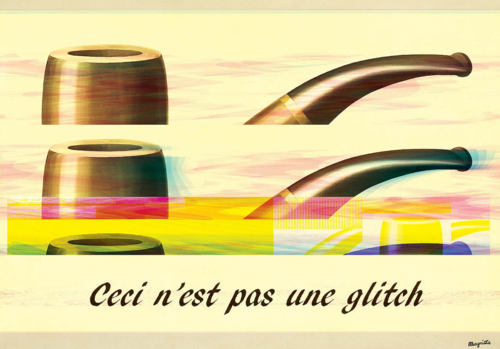This post first appeared on the Columbia at CAA blog on February 15. Author Sid Branca is a second-year media student in the InterArts Department.
NEW MEDIA LIGHTNING TALKS HIGHLIGHT: DANIEL TEMKIN ON “ALGORITHMIC ART”
On Friday afternoon the New Media Caucus hosted a series of “Lightning Talks”, 7- to 10-minute presentations on a variety of new media art-related topics, followed by a q&a discussion. I wanted to do a quick post highlighting my favorite of the talks, Daniel Temkin on how “glitch art” is often really “algorithmic art,” and the implications of that difference.

Daniel’s lightning talk was related to his piece in the Journal of Objectless Art, “Glitch && Human/Computer Interaction“. The first two sentences are so spot-on that I’m copying them here:
Glitch art mythologizes the computer error as its ultimate muse and most potent tool: the event that triggers each piece to manifest. The glitch aesthetic may be rooted in the look of malfunction, but when it comes to actual practice, there’s often not much glitch in glitch art.
Temkin argues that rather than the results of glitchy, error-filled machines, much of “glitch art” is the result of functioning machine processes, spitting out the logical results of the information and instructions given. These instructions, however, are often ”algorithms stripped of their ordinary purpose or built with no clear purpose at all”.
The most ubiquitous form of glitch art, the “broken” jpg, is rarely truly broken, as Temkin points out: ”If we still see an image, the JPEG algorithm has successfully rendered it.” It does however move from representation to abstraction, clarity to obfuscation, or to completely new and visually unrelated forms, in a way that even the artist can rarely predict. ”Glitch art underscores the computer as an apparatus indifferent to the readability or quality of the resulting image.”
Temkin continues to address the technique of “image sonification,” applying sound effects to image files to create visual effects. This tends to result in a glitchy aesthetic, but is not the erroneous processing of data, but the logical processing of data ”without the metadata which informs the machine how to interpret it, like reshaping an English sentence according to Danish rules.”
Here’s where I get really stoked:
“[W]e give up control, not to chance, but to a system with its own patterns. […] To let the brush have a mind of its own, we use systems we don’t completely understand or which are too complex to predict, allowing us to share control of the project with the machine itself.”
Temkin describes this process with this gorgeous and evocative turn of phrase: “exploring the wilderness inside the machine.” This framing of glitch art practices is really exciting to me because it brings in a sense of agency, intentionality, and collaborative exploration that sometimes feels lacking. Thinking of glitch art as a series of “accidents” can, at least for me, make the work difficult to engage with beyond a technophilic desire to see how digital objects look on the “inside”, or a sort of punk rock satisfaction in watching people break things. But as cool as the happenstance generations of a broken machine can be, glitch art is more than that. In Temkin’s definition, glitch art isn’t really glitch art but algorithmic art, the collaboration of human irrationality and curiosity with the logical but unpredictable results of technological systems, and the exploratory manipulation and curation of those results as artistic expression.

 POSTED BY
POSTED BY 